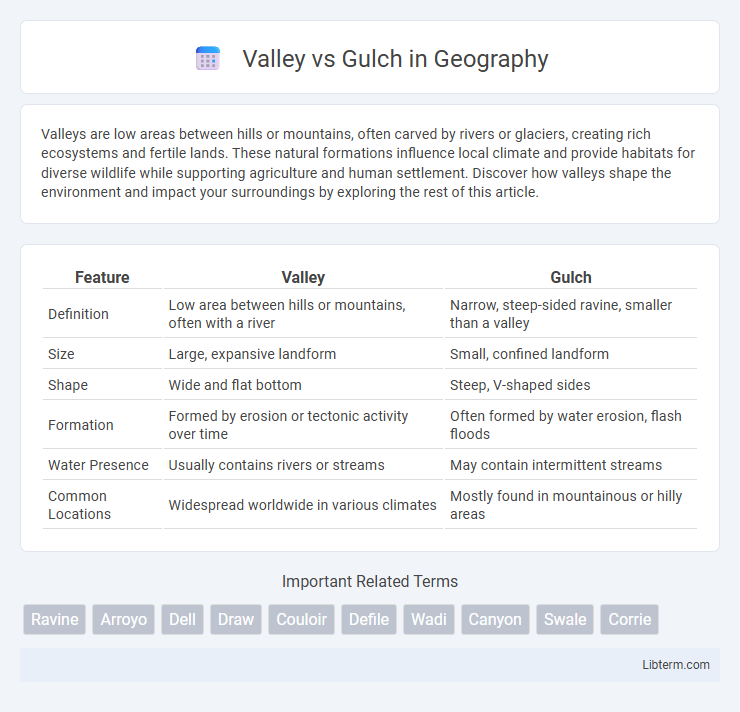Valleys are low areas between hills or mountains, often carved by rivers or glaciers, creating rich ecosystems and fertile lands. These natural formations influence local climate and provide habitats for diverse wildlife while supporting agriculture and human settlement. Discover how valleys shape the environment and impact your surroundings by exploring the rest of this article.
Table of Comparison
| Feature | Valley | Gulch |
|---|---|---|
| Definition | Low area between hills or mountains, often with a river | Narrow, steep-sided ravine, smaller than a valley |
| Size | Large, expansive landform | Small, confined landform |
| Shape | Wide and flat bottom | Steep, V-shaped sides |
| Formation | Formed by erosion or tectonic activity over time | Often formed by water erosion, flash floods |
| Water Presence | Usually contains rivers or streams | May contain intermittent streams |
| Common Locations | Widespread worldwide in various climates | Mostly found in mountainous or hilly areas |
Defining Valleys and Gulches
Valleys are broad low-lying areas between hills or mountains, often formed by river erosion or glacial activity, and typically feature fertile soil supporting diverse ecosystems. Gulches are narrower, steep-sided ravines or small valleys usually created by rapid water runoff, characterized by rugged terrain and less vegetation. Understanding the distinct geological formations and hydrological processes helps differentiate valleys from gulches in landscape analysis.
Key Geological Differences
Valleys are broad, elongated lowland areas typically formed by river erosion, characterized by gentle slopes and wide floodplains. Gulches are narrow, steep-sided ravines created primarily through rapid water erosion, often found in arid or semi-arid regions with intermittent water flow. The key geological difference lies in their scale and slope: valleys exhibit gradual terrain shaping over long periods, while gulches result from intense, localized erosion producing sharp topographical features.
Formation Processes of Valleys and Gulches
Valleys form primarily through long-term erosion by rivers or glaciers, which carve out wide, V-shaped or U-shaped depressions in the landscape. Gulches develop from intense, short-term water runoff, often in arid or semi-arid regions, creating narrow and steep-sided channels with rapid sediment removal. The key difference lies in the timescale and water flow: valleys result from sustained erosion, while gulches emerge from episodic, high-energy water flow events.
Typical Locations and Examples
Valleys commonly form in tectonically active regions, like the Great Rift Valley in East Africa and the Yosemite Valley in California, where river erosion shapes broad, U-shaped or V-shaped depressions. Gulches appear in arid or semi-arid environments, such as the American Southwest, characterized by narrow, steep-sided channels often created by intermittent water flow during flash floods. The Grand Gulch in Utah exemplifies a typical gulch, while the expansive and fertile Indo-Gangetic Plain is marked by numerous river valleys.
Size and Scale Comparison
Valleys typically span several miles and feature wide, elongated depressions formed by river erosion or glacial activity, whereas gulches are much smaller, narrow ravines often created by water runoff or flash floods. The scale of valleys supports diverse ecosystems and human settlements, contrasting with the limited space and transient water flow found in gulches. Valley dimensions can range from hundreds of meters to many kilometers, while gulches generally measure just a few meters to a few hundred meters in length and width.
Impact on Local Ecosystems
Valleys support diverse ecosystems with rich soil and abundant water flow, fostering dense vegetation and diverse wildlife habitats. Gulches, typically narrow and steep, create unique microhabitats with limited vegetation but act as crucial water channels that prevent soil erosion and support specialized plant and animal species. Both geographical features significantly influence local biodiversity and hydrological patterns, shaping ecological balance.
Historical and Cultural Significance
Valleys have historically served as fertile grounds for early human settlements due to their access to water and arable land, fostering agricultural development and sustained communities. Gulches, often narrower and steeper, were commonly used as natural pathways or defensive barriers by indigenous peoples and played roles in local folklore and territorial boundaries. The cultural significance of valleys is deeply embedded in traditional narratives and regional economies, while gulches frequently symbolize rugged wilderness and have inspired artistic representations of nature's raw beauty.
Valleys vs. Gulches: Human Settlement Patterns
Valleys, characterized by broader and more fertile land, have historically supported dense human settlements due to their access to water sources, arable soil, and transportation routes. Gulches, being narrower and often steeper with intermittent water flow, tend to have limited habitation, primarily used for resource extraction or as natural pathways. Human settlement patterns reflect these differences, with valleys hosting agricultural communities and urban centers, while gulches serve as marginal zones with sparse or seasonal occupancy.
Recreational Activities and Tourism
Valleys often attract hikers, campers, and nature photographers due to their expansive, accessible terrain and diverse ecosystems, fostering vibrant tourism industries centered around scenic trails and wildlife observation. Gulches, characterized by their narrow, steep-sided formations, appeal to adventure enthusiasts for activities like rock climbing, canyoning, and off-road exploration, offering more rugged and challenging experiences. Both landforms enhance local tourism by providing distinct recreational opportunities tailored to varied outdoor interests and skill levels.
Environmental Conservation Challenges
Valleys and gulches each present unique environmental conservation challenges due to their distinct geological and hydrological characteristics. Valleys, with their broader floors and often fertile soils, face issues like agricultural runoff, habitat fragmentation, and increased human encroachment, which can lead to loss of biodiversity and water pollution. Gulches, characterized by steep, narrow channels prone to flash floods and erosion, require targeted soil stabilization and vegetation management to prevent sedimentation and maintain ecosystem health.
Valley Infographic

 libterm.com
libterm.com